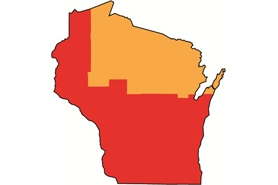European marsh thistle
(Cirsium palustre)
Herbaceous biennial or monocarpic perennial. First-year plants overwinter in the rosette stage; flowering stems are 4-5' tall, erect, thick, sometimes reddish, branched at the top and bristling with spiny wings aligned with the stem. Much of the plant is covered in long, sticky hairs.
Other names for this plant include:
- Common names: European swamp thistle, marsh thistle
Classification in Wisconsin: Prohibited/Restricted (Restricted in Ashland, Bayfield, Chippewa, [Clark,] Door, Florence, Forest, Iron, Langlade, Lincoln, Marathon, Marinette, Menominee, Oconto, Oneida, Price, Rusk, Sawyer, Shawano, Taylor and Vilas counties; Prohibited elsewhere)
- Ecological Threat
-
- It prefers moist, acidic soils and is somewhat shade tolerant. Found along roadsides, old fields, wetlands, forest edges, beaches and dune areas. In Wisconsin, European marsh thistle occurs in localized populations, primarily in northern counties.
- Once introduced, this plant can aggressively colonize natural areas, decrease biodiversity and compromise the ecological integrity of a site.
- Spontaneous hybrids between European marsh thistle and Canada thistle have been reported from European countries.
- Identification
-
Leaves: First-year rosettes are spiny, long, deeply lobed and hairy on the underside. On second-year flowering plants, leaves are 6 to 8 inches long near the base, shorter toward the top, and tipped with spines.
Flowers: Clusters of 12 or more spiny purple flower heads up to 0.75" wide; bracts have spineless tips. Typically bloom in June and July.
Fruits & seeds: Small, rugged and elongated with a tuft of feathery bristles at the top and dispersed by the wind.
Roots: Fibrous.
Similar species: Canada thistle (Cirsium arvense; invasive) has spiny leaves but non-spiny stems and flower heads. Bull thistle (Cirsium vulgare; invasive) and plumeless thistle (Carduus acanthoides; invasive) have sharply spined leaves, stems and flower heads.
Native marsh thistle (Cirsium muticum) occurs in similar habitats as European marsh thistle but has non-spiny stems and flower heads.
- Control
-
Mechanical: Hand-pull or dig rosettes. Repeated pulling and mowing (minimum three times per growing season) will weaken second-year plants; mow when flower buds are about to open.
Chemical: Foliar spray glyphosate during the early bolting phase when plants are 6-10" tall, during the bud-to-flower phase or applied to rosettes in the fall. Foliar spray with clopyralid or aminopyralid.
Biological: Field trials are ongoing in Canada using the Rhinocyllus conicus weevil.
- Resources
- Sources for content:
- Fewless, Gary. Invasive Plants of Wisconsin: Cirsium palustre [exit DNR]. Cofrin Center for Biodiversity. UW-Green Bay.
- Cao, L., J. Larson, L. Berent, and A. Fusaro. 2013. Cirsium palustre. USGS Nonindigenous Aquatic Species Database, Gainesville, FL. Eurasian marsh thistle [exit DNR]
- USDA Forest Service. 10-14-05 Weed of the Week: Marsh thistle Cirsium palustre [PDF][exit DNR]
- Encyclopedia of Life: Cirsium palustre [exit DNR]



